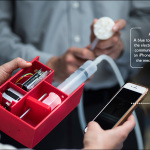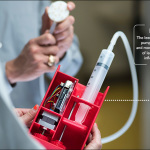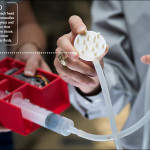 On January 17, Texas Children’s implemented barcode scanning for breast milk to reduce administration errors system-wide by ensuring that the correct breast milk is delivered to the right baby every time.
On January 17, Texas Children’s implemented barcode scanning for breast milk to reduce administration errors system-wide by ensuring that the correct breast milk is delivered to the right baby every time.
“Since 80 percent of breast milk orders originate in the NICU, we implemented barcode scanning in our Newborn Center last September as part of a pilot project which produced amazing results,” said Texas Children’s Patient Care Services and Clinical Informatics Director Jennifer Sanders. “We are excited to deliver this functionality across our Medical Center campus, the Pavilion for Women and West Campus.”
Using the same barcode scanning system to prevent medication administration errors, the Positive Patient Identification (PPID) process incorporates Epic Rover, a mobile software application that uses barcode technology to positively match breast milk orders to the right patient, subsequently reducing the potential risk of adverse patient safety events during the milk handling process.
Once Epic Rover is downloaded to an iPod Touch equipped with a scanner or sled, a nurse scans the barcode on the patient’s wristband and the barcode on the breast milk container at the patient’s bedside instead of having to manually check it prior to a feeding. The milk order documentation then flows real-time from Epic Rover into Epic, which also documents any supplements added to the breast milk.
“Since using Epic Rover in our Newborn Center, our compliance rates have consistently soared above the 95 percent goal,” said Texas Children’s Clinical Informatics Manager Erin Davies. “We have avoided documented near misses where Epic Rover detected the wrong breast milk with the wrong baby, which demonstrates the tremendous impact barcode scanning has on ensuring the safety of our patients.”
The successful implementation of Epic Rover at Texas Children’s involved the collaboration of several departments including Clinical Informatics, Information Services, Food and Nutrition Services, Milk Bank, Pharmacy, Nursing, and the Nursing Professional Development team that helped apply PPID safety protocols to breast milk.
Barcode scanning for breast milk will also go live at Texas Children’s Hospital The Woodlands when the facility opens this spring.









